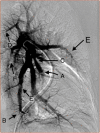Balloon Pulmonary Angioplasty: State of the Art
- PMID: 33664801
- PMCID: PMC7903587
- DOI: 10.15420/icr.2020.14
Balloon Pulmonary Angioplasty: State of the Art
Abstract
Balloon pulmonary angioplasty (BPA) is a novel technique for the treatment of chronic thromboembolic pulmonary hypertension. While cardiologists need no introduction to the concept of balloon angioplasty, BPA has its own particular challenges. This article aims to provide the reader with an overview of BPA, starting with an introduction to chronic thromboembolic disease (CTED), the standard management of chronic thromboembolic pulmonary hypertension (CTEPH), technical challenges faced when performing BPA and the evidence base supporting its use. The second part of the article will focus on the future of BPA, in particular the areas where research is required to establish an evidence base to justify the role of BPA in CTEPH and CTED treatment.
Keywords: Thromboembolic; angioplasty; complications; endarterectomy; pulmonary; riociguat; thromboembolism.
Copyright © 2020, Radcliffe Cardiology.
Conflict of interest statement
Disclosure: JC performs balloon pulmonary angioplasty at Royal Papworth Hospital. Unrelated to the current work he receives grants from Johnson & Johnson and Merck. He undertakes consultancy work and has received honoraria from Johnson & Johnson, GSK, Bayer and Endotronix. AR performs balloon pulmonary angioplasty at Royal Papworth Hospital. Unrelated to the current work he receives grants from Johnson & Johnson, Novartis, Medtronic and Abbott. He undertakes consultancy work and has received honoraria from Johnson & Johnson, SoniVie and Endotronix. SH performs balloon pulmonary angioplasty at Royal Papworth Hospital. Unrelated to the current work he has received research grants from AstraZeneca and Abbott Vascular. He undertakes consultancy work and has received honoraria from AstraZeneca, Bayer, Abbott Vascular and Boston Scientific.
Figures
Similar articles
-
Balloon pulmonary angioplasty for chronic thromboembolic pulmonary hypertension.Cardiovasc Interv Ther. 2020 Apr;35(2):130-141. doi: 10.1007/s12928-019-00637-2. Epub 2019 Dec 23. Cardiovasc Interv Ther. 2020. PMID: 31873853 Review.
-
Emerging Role of Balloon Pulmonary Angioplasty in Chronic Thromboembolic Pulmonary Disease-Insights from the 2022 ESC Guidelines.J Clin Med. 2023 Aug 16;12(16):5336. doi: 10.3390/jcm12165336. J Clin Med. 2023. PMID: 37629379 Free PMC article. Review.
-
Balloon Pulmonary Angioplasty in Patients With Thromboembolic Pulmonary Hypertension.Curr Treat Options Cardiovasc Med. 2018 Feb 24;20(2):13. doi: 10.1007/s11936-018-0604-4. Curr Treat Options Cardiovasc Med. 2018. PMID: 29478193 Review.
-
Advances in balloon pulmonary angioplasty for chronic thromboembolic pulmonary hypertension.Pulm Circ. 2021 May 24;11(2):20458940211007385. doi: 10.1177/20458940211007385. eCollection 2021 Apr-Jun. Pulm Circ. 2021. PMID: 34104421 Free PMC article. Review.
-
Balloon pulmonary angioplasty for inoperable patients with chronic thromboembolic disease.Pulm Circ. 2018 Jan-Mar;8(1):2045893217753122. doi: 10.1177/2045893217753122. Epub 2017 Dec 28. Pulm Circ. 2018. PMID: 29283044 Free PMC article.
Cited by
-
Balloon pulmonary angioplasty outcomes in patients previously treated by pulmonary endarterectomy surgery are inferior to those of inoperable patients.Pulm Circ. 2023 Jul 4;13(3):e12265. doi: 10.1002/pul2.12265. eCollection 2023 Jul. Pulm Circ. 2023. PMID: 37415805 Free PMC article.
-
Balloon pulmonary angioplasty for chronic thromboembolic pulmonary hypertension: a clinical consensus statement of the ESC working group on pulmonary circulation and right ventricular function.Eur Heart J. 2023 Aug 1;44(29):2659-2671. doi: 10.1093/eurheartj/ehad413. Eur Heart J. 2023. PMID: 37470202 Free PMC article.
-
Verification of Optimal Balloon Size in Balloon Pulmonary Angioplasty for Chronic Thromboembolic Pulmonary Hypertension.Cardiovasc Intervent Radiol. 2023 Jul;46(7):967-969. doi: 10.1007/s00270-023-03489-9. Epub 2023 Jun 13. Cardiovasc Intervent Radiol. 2023. PMID: 37311837 Free PMC article. No abstract available.
-
Acute lung injury after balloon pulmonary angioplasty results in a similar haemodynamic response and possible clinical advantage at follow-up.Pulm Circ. 2022 Oct 1;12(4):e12166. doi: 10.1002/pul2.12166. eCollection 2022 Oct. Pulm Circ. 2022. PMID: 36568689 Free PMC article.
-
Effect of balloon pulmonary angioplasty on chronic thromboembolic pulmonary hypertension: an assessment of the learning curve in a Japanese university hospital.Cardiovasc Interv Ther. 2025 Apr;40(2):389-399. doi: 10.1007/s12928-024-01076-4. Epub 2024 Dec 30. Cardiovasc Interv Ther. 2025. PMID: 39738922 Free PMC article.
References
Publication types
LinkOut - more resources
Full Text Sources
Other Literature Sources






